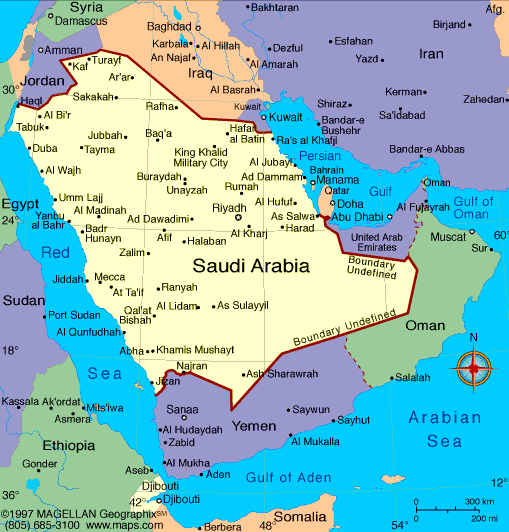Saudi Arabia Map: Regions, Geography, Facts & Figures
The Kingdom of Saudi Arabia, nestled in the heart of the Middle East on the Arabian Peninsula, is a country rich in history and culture. Bordered by Iraq, Jordan, Kuwait, Oman, Qatar, the United Arab Emirates, and Yemen, Saudi Arabia serves as a central hub for the region. Its significant role in Islam, with sacred cities such as Mecca (Makkah) and Medina (Madinah), further cements its importance globally.
The capital city, Riyadh, along with major cities like Jeddah and Dammam, contribute to the diverse cultural landscape of the kingdom. The country's official language is Arabic, although English is widely spoken in business and educational sectors.
If you want to discover more in-depth information on Saudi Arabia as a country, check out our Saudi Arabia Profile!
Plus, test your country knowledge with our Middle Eastern geography quiz on Saudi Arabia Map!

History of Saudi Arabia
Saudi Arabia's roots extend deep into ancient times, with civilizations like the Nabateans and the Lihyanites leaving their mark on the region. The birth of Islam in the 7th century in Mecca, where Prophet Muhammad was born, united the Arabian tribes under a single religious banner.
The Al Saud family established the first Saudi state in the 18th century, which Abdulaziz Ibn Saud further expanded and consolidated in the early 20th century. Saudi Arabia's vast oil reserves have since made it a key player in regional and global politics.
Despite being situated thousands of miles from Europe, Saudi Arabia shares a connection in the form of cultural exchanges, trade, and even geographical proximity. Earth's intricate web of landscapes and cultures only serves to emphasize our interconnectedness!
Geography of Saudi Arabia
As the largest country in the Middle East, Saudi Arabia spans approximately 2.15 million square kilometers. Its geography is primarily characterized by desert landscapes, including the Rub' al Khali or the Empty Quarter, one of the world's largest continuous sand deserts.
The Asir Mountains and various wadis, dry riverbeds that fill with water during rainfall, add to the country's diverse terrain. The Red Sea to the west and the Arabian Gulf (also known as the Persian Gulf) to the east outline Saudi Arabia's coastline.
Saudi Arabian Political Map and Borders
The political map of Saudi Arabia reveals its strategic location on the continent of Asia, sharing borders with several Middle Eastern and African countries. To the north, it is bordered by Jordan and Iraq, while Yemen lies to the south.
It shares its eastern boundaries with Kuwait, Bahrain, Qatar, and the United Arab Emirates, while Oman is situated to the southeast. The Red Sea forms its western border, opposite to which lies Sudan, Egypt, and Eritrea in Africa. Across the Persian Gulf to the northeast, one can find Iran.
Major Cities in Saudi Arabia
While Riyadh, Jeddah, and Dammam are commonly known, Saudi Arabia is also home to other notable cities and regions. The city of Tabuk, for instance, located in the northwestern part of Saudi Arabia, features interesting archaeological sites and a unique desert landscape. In the north-central region of the country lies Ha'il, known for its agricultural contributions and rich cultural heritage.
Tourist Attractions in Saudi Arabia
Saudi Arabia boasts a plethora of tourist attractions. Islam's holiest cities, Mecca and Medina, attract millions of pilgrims annually. Jeddah, known for its traditional architecture and bustling markets, offers a glimpse into Saudi Arabia's rich history. Riyadh, the capital city, is a blend of modernity and culture, with attractions like the National Museum and the Kingdom Centre Tower.
Further north along the Saudi Arabian coast, the Gulf of Aqaba, a narrow strip of sea bordered by Jordan and Egypt, creates a unique marine environment with diverse aquatic life. This body of water extends to the Hejaz region, a historically significant area that includes the holy cities of Mecca and Medina.
Additionally, the UNESCO World Heritage site of the ancient Nabatean city of Madain Saleh houses impressive rock-cut tombs and archaeological ruins. For nature enthusiasts, the Red Sea coast promises a unique underwater experience, while the Empty Quarter provides an unforgettable desert adventure.
People Also Ask…
If you're inspecting the Saudi Arabia map, you may have some queries about the region. Here are some of the most frequently asked questions, along with their answers.
What Was Saudi Arabia Called Before 1932?
Before 1932, the region now known as Saudi Arabia was called the Kingdom of Hejaz and Nejd. The name changed when Abdul Aziz Al-Saud created the Kingdom of Saudi Arabia by unifying Hejaz and Nejd.
What Country Does Saudi Arabia Come Under?
Saudi Arabia is a sovereign state located in the Middle East. It shares its borders with Jordan, Iraq, Kuwait, Qatar, Bahrain, the UAE, Oman, and Yemen.
Is Saudi Arab in Asia or Africa?
Saudi Arabia is located in the continent of Asia. It occupies most of the Arabian Peninsula, which is part of Western Asia.
What Is the Main Religion in Saudi Arabia?
Islam is the official religion and is practiced by at least 90% of the population.[1] The remaining 8–10% practice Christianity, Hinduism, Buddhism, or other religions. Additionally, non-religious beliefs are also present in the country.
|
|
Sources
[1] Saudi Arabia - The APPG for International Freedom of Religion or Belief. (2021, November 18). The APPG for International Freedom of Religion or Belief. Retrieved on October 24, 2023, from https://appgfreedomofreligionorbelief.org/saudi-arabia/








